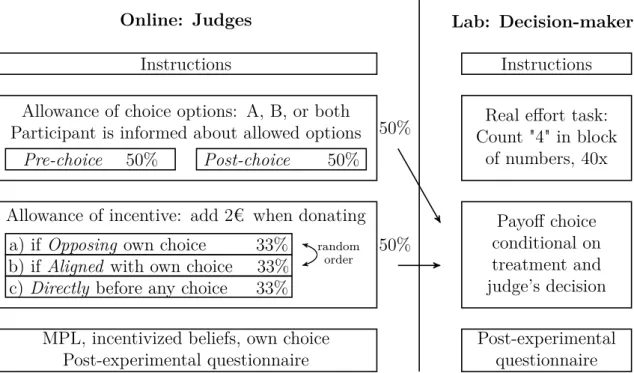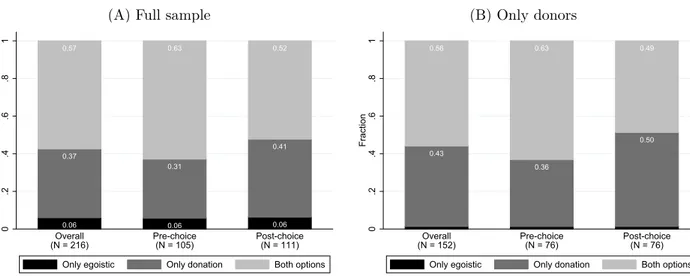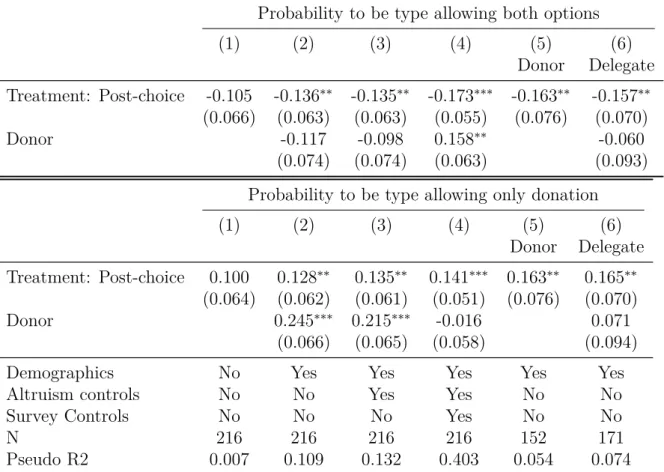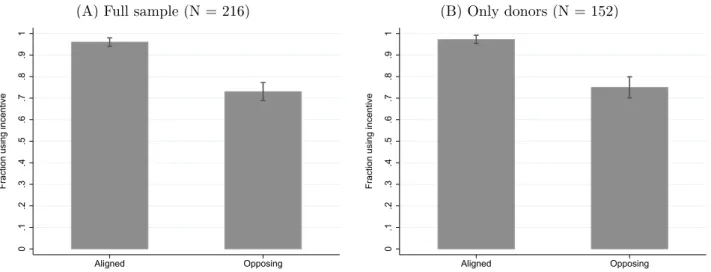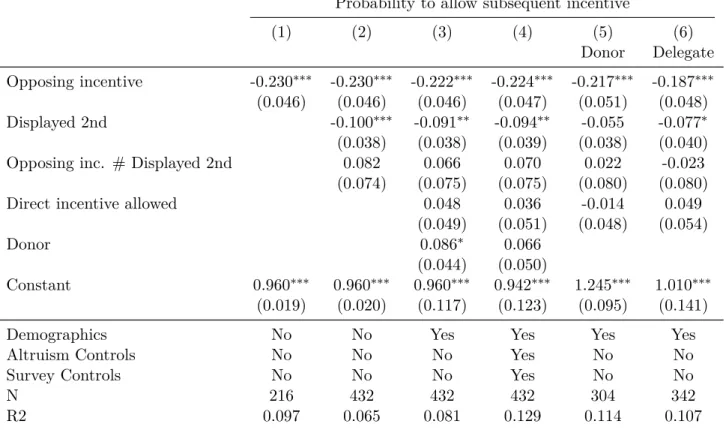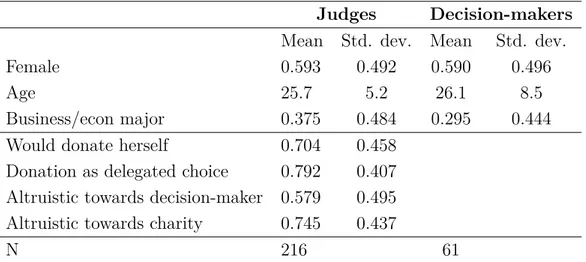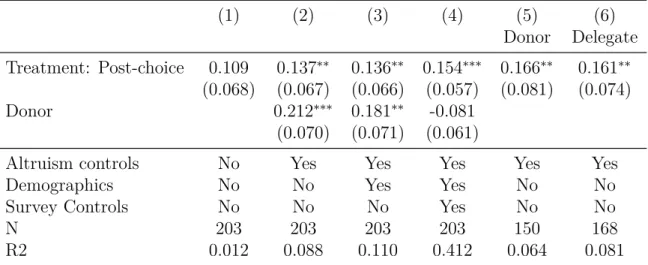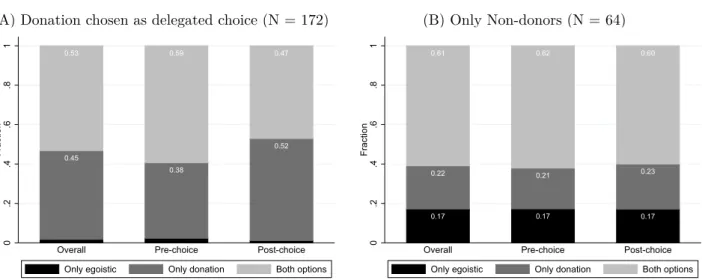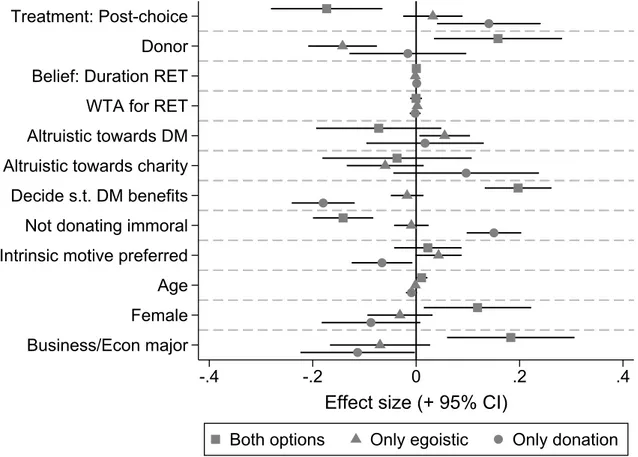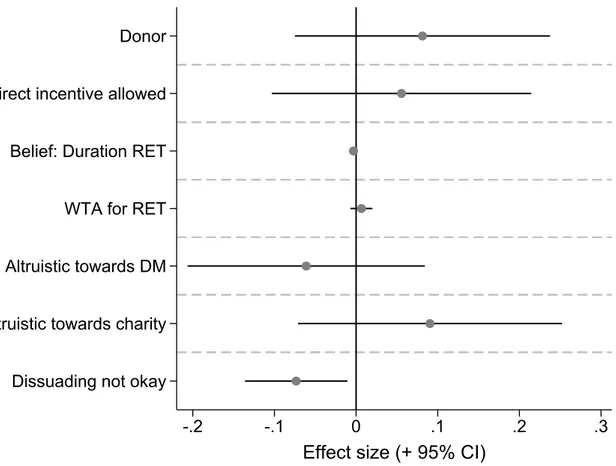Do People Intervene to Make Others Behave Prosocially?
Viola Ackfelda, Axel Ockenfelsa,∗
aUniversity of Cologne, Albertus-Magnus-Platz, 50923 Cologne, Germany
Abstract
We experimentally investigate people’s willingness to intervene in others’ decision-making in order to promote a charitable donation. We find that only a minority of those subjects who would donate themselves enforce the donation by banning the selfish choice from the decision- maker’s choice menu. Bans are more acceptable if they are implemented only after the decision- makers could choose between the selfish and the prosocial option themselves. Also, many subjects decide against offering decision-makers a monetary incentive to switch from the selfish to the prosocial choice. We discuss potential hypotheses about underlying motivations for the (non-) usage of interventions, with a special focus on the hypothesis that interventions to promote prosocial choice are more acceptable the more they respect the autonomy of others.
Keywords: Charity experiment, Prosocial behavior, Autonomy, Bans, Incentives 1. Introduction
The question which interventions increase prosocial behavior has gained much attention in empirical economic research (Andreoni (2015) and Lacetera et al. (2013) provide reviews on how to increase charitable fundraising and blood donations, respectively). However, the question which interventions are perceived as “acceptable” has gained much less attention. In this paper, we investigate which interventions otherwise unaffected third parties are willing to use in order to influence others’ prosocial behavior. In particular, we consider two kinds of interventions:
bans that directly enforce the prosocial action by removing the selfish option, and monetary payments that incentivize the prosocial action. One conjecture motivating our study is that the choice (not) to intervene may be driven by a desire to preserve others’ autonomy.
Specifically, in our study, we let participants in an online experiment, called judges, decide about the rules that other participants in a subsequent lab experiment, called decision-makers, face. Without any own monetary stakes involved, judges decide whether to use bans and incentives to influence decision-makers’ choice between a charitable donation of 10€, which yields a small payoff of 3€ for the decision-maker, and a large payoff of 10€ for the decision- maker that precludes, however, the donation. Each donation finances an eye surgery against blinding in Ethiopia.
In our main choice treatment, judges can either choose a ban to take away one of the two choice options from the decision-maker, or they can leave his choice set unaffected. We
∗Corresponding author
Email address: ockenfels@uni-koeln.de(Axel Ockenfels)
vary whether the decision-maker is informed about the judge’s decision before (Pre-choice) or after (Post-choice) he made his own choice. While the former treatment variation leaves no room for the decision-maker to make a choice himself, the latter variation grants autonomy for doing good, but the judge may still alter the outcome in case the donation is not chosen.
In a second choice treatment, judges can offer those decision-makers who initially chose to be selfish an additional private bonus of 2€ if they change their decision into a donation (Opposing incentive). As a control, the bonus can also be offered to those choosing the donation anyway (Aligned incentive). None of those interventions affects judges’ payoffs; granted bonuses are paid by the experimenter.
A straightforward prediction in our settings would be that judges who would donate them- selves choose to implement interventions that push decision-makers to also donate. To see why, suppose an altruistic judge values a dollar for the charity higher than a dollar for herself (and thus would donate herself), yet values a dollar for herself higher than a dollar for the decision-maker (a reasonable assumption if judges and decision-makers are randomly drawn from the same subject population as it is the case in our experiment). Then, assuming that procedural aspects of donations are irrelevant, this judge should be willing to use bans and monetary incentives to promote a donation. A judge with this motivation will in the following be described as “outcome-centered”.
In contrast, an unwillingness to push others to behave prosocially, along with possible treatment effects, can occur if judges care about procedural aspects of interventions – how others are pushed to donate. One natural candidate is that judges wish to respect the decision- maker’s autonomy. Indeed, according to scholars in philosophy, autonomy – freedom from external control or influence – possesses a non-instrumental, inherent value, which should be respected (Feinberg, 1978; Rawls, 1971, 1980; Young, 1982). Previous research in behavioral economics has shown that autonomy may affect economic outcomes (Bartling et al., 2014, 2012;
Benz and Frey, 2008; Burdin et al., 2018; Cassar and Meier, 2018; Falk and Kosfeld, 2006; Fehr et al., 2013; Leider and Kessler, 2016). If judges respected others’ autonomy, they might refrain from any interventions to push the decision-maker towards a donation, even if they donated themselves. And if they intervene, interventions may be more acceptable the more they respect the autonomy of others. For instance, while Pre-choice bans leave no room for the decision- maker to make a choice himself, Post-choice bans grant at least autonomy for doing good, and only alter the outcome in case the donation is not chosen. Monetary incentives allow choice, but may stand in conflict with some notion of autonomy – if trying to dissuade people from the choice they would have made without being incentivized, as has been forcefully argued by Grant (2006, 2011). This might suggest that Opposing incentives are less attractive than Aligned incentives.
Our main treatment data show that, surprisingly, more than half of the judges who donate themselves do not implement bans at all. Among those judges who intervene, we observe that bans are more acceptable if the decision-maker is informed about the intervention only after he made his choice and the intervention only comes into effect in case the choice is
inconsistent with the ban. Monetary incentives are more acceptable if the incentive is not used to dissuade a decision-maker who previously decided not to donate. This overall pattern of interventions is broadly consistent with the notion that many judges desire to respect the decision-makers’ demand for autonomy. However, for instance the fact that we do not find a statistical relationship between subjects’ willingness to use bans on the one hand, and incentives to influence others’ donation behavior on the other hand, suggests that a full account of the underlying motivations that drive many judges’ unwillingness to push decision-makers to act prosocially may extend beyond a simple concern for autonomy.
Our study is related to several strands of literature. Autonomy is a well-studied concept in philosophy. Besides its instrumental value of enabling people to decide for themselves, scholars also attribute a non-instrumental, inherent value to it (Feinberg, 1978; Rawls, 1971, 1980; Young, 1982). Additionally, autonomy together with relatedness and competence is a key component in self-determination theory (Deci and Ryan, 1985; Ryan and Deci, 2000) in psychology to motivate people, generating actions of superior quality than under extrinsic rewards like money (Lepper et al., 1973; Lepper and Greene, 1978; Titmuss, 1970). Recent economic research supports both empirically and theoretically that intrinsic motivation matters (Bénabou and Tirole, 2003, 2006; Bowles and Polania-Reyes, 2012; Frey and Oberholzer-Gee, 1997). In the context of prosocial activities, Ashraf et al. (2014) and Gneezy and Rustichini (2000) find that paying subjects for charitable fundraising activities decreases effort. When looking at autonomy in particular, there is laboratory evidence that people value to decide on their own (Bartling et al., 2014) and that they reduce their effort when experiencing more control and thereby less autonomy (Bartling et al., 2012; Falk and Kosfeld, 2006; Fehr et al., 2013). Leider and Kessler (2016) highlight that this negative reaction to control stems from procedural fairness concerns being violated, while Burdin et al. (2018) find no negative reactions to control but rather positive reactions if principals refrain from exerting control on agents. Using survey data, Benz and Frey (2008) show that self-employed people seem to gain procedural utility from being able to decide autonomously. While the conflict of bans with autonomy is rather obvious, incentives conflict with autonomy according to political scientist Grant (2006, 2011) insofar that they do not respect a choice an individual, capable of making moral choices, makes on his own. According to Grant, incentives may therefore be considered as a form of power trying to change one’s own decision. This may lead to a decision “against own better judgment” which interferes with autonomy. We add to this literature by studying under which circumstances people refrain from intervening into others’ prosocial decision-making.
With reference to research on philanthropy, there are various attempts like matching do- nations (Eckel and Grossman, 2003; Huck and Rasul, 2011; Huck et al., 2015; Meier, 2007), seed money and refunds (List and Lucking-Reiley, 2002) or peer comparison (Meer, 2011) to increase charitable giving. See Andreoni (2015) for a collection of influential papers. Similarly, several studies test monetary as well as non-monetary incentives to increase blood (Goette and Stutzer, 2008; Lacetera and Macis, 2010, 2013; Lacetera et al., 2014) as well as organ donations (Eyting et al., 2016; Kessler and Roth, 2012; Mellström and Johannesson, 2010). Our project
extends this research by looking at third-parties’ willingness to intervene in others’ prosocial decision-making. In this sense, it complements a study by Butera and Houser (2018), who find that charitable giving does not decrease if delegated. While Jacobsson et al. (2007) look atwhat kind of donations people prefer to give to others, in their case in-kind rather than monetary donations, our focus lies on the interventional tool people use to channel the donation behavior of others in light of its conflict with autonomy.
From a methodological perspective, our experimental design overlaps with studies deploy- ing so-called spectator designs (Almas et al., 2020; Cappelen et al., 2013) to investigate third- parties’ willingness to intervene in others’ outcomes, often in redistribution settings. In a setting with time-delayed payments, Ambuehl et al. (2021) use a related design to study pa- ternalistic interventions into others’ choice set and find substantial intervention rates. Taking the perspective of third-parties is useful for investigating what interventions are considered as
“acceptable” (see also the literature on repugnance in the domain of organ or blood donations (Roth, 2007, 2018)). Without such knowledge, barriers to the implementation of interventions may be overseen.
The rest of the paper is structured as follows. In section 2, we present our experimental design. Section 3 presents the results and Section 4 relates them to standard social utility models. The last section concludes.
2. Experimental Design
Our experiment consists of an online part and a laboratory part. Participants in the online part, called judges, can set the rules of the subsequent laboratory part, thereby determining the choice sets and payoffs of the participants in the laboratory, called decision-makers. In what follows, we refer to a judge as “she” and to a decision-maker as “he”. Figure 1 depicts the structure of the experiment. Screenshots of how treatments are implemented as well as instructions for both parts of the experiment can be found in Appendix B.
2.1. Laboratory part of the experiment
Decision-makers in the laboratory part first have to work on a real-effort task and can then choose between two payoff alternatives. The real-effort task consists of correctly counting how often the number “4” is included in a block of numbers and is repeated 40 times. An example for such a counting task is provided in the instructions in Appendix B.2. The task is a version of that used in Abeler et al. (2011), generates no value for the experimenter nor pleasure for subjects completing it, but requires costly effort, which in turn might increase the subjects’
perception of entitlement to a larger payoff.
After finishing the real-effort task, decision-makers can pick one of two payoff alternatives.
They either receive a payoff of 10€ and do not donate any money, or they receive a payoff of 3€
while donating 10€ to the German charity “Menschen für Menschen”. The donation finances an eye surgery in Ethiopia against blinding from the disease trachoma, the world’s most common bacterial reason for blindness. We show pictures of the surgery and provide details regarding
Figure 1: Structure of the experiment
Online: Judges
Instructions
Allowance of choice options: A, B, or both Participant is informed about allowed options
Pre-choice 50% Post-choice 50%
Allowance of incentive: add 2€ when donating a) if Opposing own choice 33%
b) if Aligned with own choice 33%
c) Directly before any choice 33%
MPL, incentivized beliefs, own choice Post-experimental questionnaire
Lab: Decision-makers
Instructions Real effort task:
Count "4" in block of numbers, 40x
Payoff choice conditional on treatment and judge’s decision Post-experimental
questionnaire 50%
50%
random order
Notes: Probabilities reported as %. Treatment differences in italics. MPL refers to the multiple price lists for constructing altruism controls.
the causes and consequences of the disease in the instructions. We inform participants that we are going to upload donation receipts on our website after the experiment for verification purposes. After the payoff choice is made, the laboratory part of the experiment ends with a brief post-experimental questionnaire.
2.2. Online part of the experiment and hypotheses
Judges in the online part of the experiment determine the rules of the laboratory part.
Their own payoff for this task is fixed at 4€. Judges can gain a bonus as explained below; the bonus does not relate to their decisions (not) to intervene. Since we recruit more judges than decision-makers, we randomly draw whose judges’ decisions are implemented, and then match each of these judges to one decision-maker. Judges make two kinds of decisions, one of which is selected with 50% probability and implemented.
Main treatment: Bans. The first and main decision concerns judges’ preference over the choice set of decision-makers. Judges can choose between allowing both payoff alternatives, the selfish alternative only, or the donation only. As explained in the introduction, by a straight- forward choice model, an outcome-centered judge who would donate herself would ban the selfish option. Yet, procedural aspects of interventions may be relevant, too, such as a desire to respect decision-makers’ autonomy. This motivation may lead to some judges abstaining from an intervention even if they donate themselves. We call this a procedure-centered motivation for interventions. This leads us to the following hypotheses regarding the use of bans.
Hypothesis 1a (Outcome-centered motivation): Judges use bans to enforce charitable giving if they donate themselves.
Hypothesis 1b (Procedure-centered motivation): Judges do not use bans even if they donate themselves.
We randomly assign subjects into two treatments. In the Post-choice treatment, the decision-maker makes a choice and learns afterwards whether this choice is allowed by the judge matched to him.1 If it is allowed, it is implemented. Otherwise, it is overridden by the other option. In the Pre-choice treatment, options not allowed are already blanked out on the choice screen of the decision-maker, so he does not have to make a choice at all. In contrast, in the Post-choice treatment, any interference only emerges after the decision-maker had the opportunity to do good himself, and only if he decided in misalignment with what his judge allowed. Both options require judges to determine the set of possible outcomes, and they only differ by the procedure by which this set is determined. While the Pre-choice treatment directly implements the outcome, judges in the Post-choice treatment can let decision-makers first decide on their own, possibly preserving a feeling of autonomy for the donation-willing individuals, and afterwards enforce the implementation of the prosocial outcome for those who are not willing to donate. This leads us to our second set of hypotheses.
Hypothesis 2a (Outcome-centered motivation): Judges use bans equally often in the Pre- choice and Post-choice treatment.
Hypothesis 2b (Procedure-centered motivation): Judges use bans less often in the Pre-choice than in the Post-choice treatment.
An interesting alternative “procedural” hypothesis is that choice involving a trade-off be- tween selfishness and prosociality may be regarded by judges as a burden rather than an opportunity (as pointed out by Heath and Tversky (1991), Loewenstein (1999), Sunstein (2014, 2015), and Tversky and Shafir (1992)), and judges may want to altruistically free decision- makers from such a burden. In this case, bans should be more attractive in the Pre-choice treatment:
Hypothesis 2c (Unburdening from choice): Judges use bans more often in thePre-choice that in the Post-choice treatment.
Second treatment: Incentives. The second decision that judges make concerns whether or not the decision-maker should get a 2€ extra incentive which is added from the experimenter’s account to the decision-maker’s payoff if he donates. If used, the decision-maker’s own payoff from donation increases from 3€ to 5€. Here, judges have to make three within-subject decisions out of which one is randomly chosen and implemented with equal probability. They have to decide about an Opposing incentive, an Aligned incentive, and a Direct incentive. We consider an incentive as Opposing if it is offered to the decision-maker for donating after he
1Whenever a decision-maker makes a choice, he knows that another participant has previously determined the rules for the lab experiment, but does not know what particular choice is affected and how. Importantly, he does not know that his choice may be overridden or that there may be the possibility to revise his choice.
initially decided against donation. TheAligned incentive is added after the decision-maker has initially donated, thereby raising the decision-maker’s payoff of the option he already chose.
In both cases, decision-makers get the opportunity to subsequently revise their initial choice (which is shown as the default on the later screen) after having seen the additional incentive.
Moreover, we randomize the order by which the judge decides about the Opposing and the Aligned incentive. The Direct incentive serves as an additional control to rule out an aversion to adding 2€ per se and is always implemented only after judges have already decided about the Opposing and the Aligned incentive. Unlike the other incentives, a Direct incentive increases the decision-maker’s payoff right from the beginning. This means that the respective decision- maker would not even see the initial payoff alternative (3€ for decision-maker, 10€ donation), but directly gets his own payoff in case of donation displayed as 5€.
A judge with an outcome-centered motivation, in particular if she donated herself, would try to attract more donations. New donations can only be attracted byOpposing incentives via making initially donation-unwilling individuals switch to the donation. Aligned incentives raise the payoff of donors but cannot attract more donations to charity. Hence, outcome-focused judges should use the Opposing incentive (weakly) more often than the Aligned incentive to implement the desired donation outcome.
In contrast, procedure-centered motivations would suggest that judges find the Aligned in- centive more attractive. If judges are concerned about decision-makers’ autonomy, following the reasoning of Grant (2006, 2011), the Opposing incentive is less attractive compared to the Aligned incentive since the former attempts to change the decision-maker’s own, initial choice and in this sense disrespects the decision-maker’s autonomous will. Thus, a judge concerned about this notion of autonomy should use Opposing incentives less often than Aligned incen- tives.2
Hypothesis 3a: (Outcome-centered motivation): Judges intervene (weakly) more frequently byOpposing than byAligned incentives.
Hypothesis 3b (Procedure-centered motivations): Judges intervene less frequently by Oppos- ing than byAligned incentives.
Additional elicitations and experimental procedures. We collect several beliefs, attitudes, and other measures related to our setting after all decisions described above were made. Most importantly, judges have to make a choice between the two payoff alternatives for themselves, and we randomly pick one judge for whom this decision is implemented. Choosing the donation herself serves as our first measure of whether a judge cares about the charity. We also give 10%
of decision-makers the chance to delegate the payoff choice to a judge, and let judges make a separate decision between the two payoff alternatives for such a situation. This serves as our second measure to identify to what extent the judge cares about the charity. Moreover, we
2Section 4 discusses another procedure-based hypothesis yielding the same prediction.
control for contextual factors that might influence judges’ perception of decision-makers’ choice situation, namely effort costs and duration of the previous real-effort task.3
On top of that, we measure judges’ general valuation for allocating money (paid from the experimenter’s account) to the decision-maker or the charity, respectively, via multiple price lists. One list item is randomly chosen and implemented in 10% of the cases independently from any previous choice. Judges can deduct up to 3€ from the payoff of the decision-maker or the charity, respectively, or add up to 5€ to it. Based on these decisions, we construct a measure of altruism, i.e., we call a judge “altruistic” if she always gives money to and never takes money from the decision-maker. We use an equal measure with reference to the charity. This way, we can control for potential confounds, e.g., spite or the potential role of inequality aversion towards the decision-maker. Furthermore, we elicit demographics and several attitudes related to our setting in a post-experimental questionnaire.
We recruited both judges and decision-makers from the subject pool of the Cologne Lab- oratory for Economic Research (CLER) using ORSEE (Greiner, 2015). Data collection for both parts of the experiment took place in August 2018, programmed in oTree (Chen et al., 2016). In total, 216 subjects participated in the online part and 61 in the laboratory part of the experiment. Descriptive statistics for the lab and online samples can be found in Tables A.1 and A.2 in the Appendix. Participants in the laboratory part earned on average 11.66€
in 45-minute sessions including a 4€ show-up fee. Online sessions took place within one week and lasted 13 minutes on average. Judges received 4€ lump-sum in cash for participation in the week after the experiment.4 Except the bonus for the real-effort tasks, bonuses for judges were paid out separately after the laboratory part had taken place. We informed participants via email and via our homepage about who received a bonus. All cash payments were executed via anonymous participation codes.
3. Results
3.1. Use of bans
We first investigate judges’ willingness to use bans with data pooled over the Pre-choice and Post-choice treatments, as shown in the left bar of Figure 2, Panel A. The majority of judges leaves the decision-maker’s choice set unrestricted, thereby granting decision-makers full
3We ask for judges’ willingness to accept completing the real-effort task themselves using the BDM- mechanism (Becker et al., 1964). Judges can state any integer amount between 0 and 20€, and we randomly choose one judge who has to solve the 40 counting tasks on her own after the online experiment if her willingness to accept is low enough. With reference to the task’s duration, judges guess how long it takes for decision-makers to finish the real-effort task. We elicit this belief in an incentive-compatible way by offering the judge with the guess closest to the true value a bonus of 5€, paid out after the laboratory experiment. In the same way, judges guess which fraction of decision-makers considers the choice between the two payoff alternatives as difficult, and which fraction would like to delegate it.
4Judges collected their payoff at our office on campus. Besides the one-week payout period, we added three more days for payoff: One day the week after the bonus was announced (i.e., two weeks after the laboratory experiment) and two days in the first week of the new lecture period. We decided to announce the two subsequent payoff days since we run our experiment during the term break, which resulted in a rather low pick-up rate of payoffs. In total, 47.2% of judges picked up their payoff.
autonomy to decide themselves. 43% of judges use bans. While a few judges, 6%, take away the option to do good and do not allow the donations, 37% enforce the donation. This distribution is highly statistically different from a distribution in which all judges enforce the donation (p <0.001,X2-test).5 Moreover, it stands in stark contrast to judges’ own prosociality: Overall, 70.4% of judges choose to donate themselves, and 79.2% select the donation on behalf of the decision-maker in case the decision-maker waives his right to decide himself.
When restricting the sample to judges choosing the donation themselves, a surprising share of 56% leaves the decision-makers’ choice set untouched as displayed in the left bar of Figure 2, Panel B. Overall, observing the majority of prosocial judges refraining from an intervention by a ban strongly confirms Hypothesis 1b, and is consistent with the notion that judges take decision-makers’ autonomy into account when considering to intervene.
Figure 2: Use of bans overall and by treatment (A) Full sample
0.06 0.37 0.57
0.06 0.31 0.63
0.06 0.41 0.52
0.2.4.6.81Fraction
Overall
(N = 216) Pre-choice
(N = 105) Post-choice
(N = 111) Only egoistic Only donation Both options
(B) Only donors
0.01 0.43 0.56
0.01 0.36 0.63
0.01 0.50 0.49
0.2.4.6.81Fraction
Overall
(N = 152) Pre-choice
(N = 76) Post-choice
(N = 76) Only egoistic Only donation Both options
Notes: Full sample and restricted sample of judges donating themselves.
Result 1: The majority of judges does not ban the selfish option of others despite being willing to donate themselves.
5The distribution is also different from one in which judges randomize between the three options in case they do not care (p <0.001,X2-test).
Table 1: Average marginal effects of allowing full/restricted choice set by treatment
Probability to be type allowing both options
(1) (2) (3) (4) (5) (6)
Donor Delegate Treatment: Post-choice -0.105 -0.136∗∗ -0.135∗∗ -0.173∗∗∗ -0.163∗∗ -0.157∗∗
(0.066) (0.063) (0.063) (0.055) (0.076) (0.070)
Donor -0.117 -0.098 0.158∗∗ -0.060
(0.074) (0.074) (0.063) (0.093) Probability to be type allowing only donation
(1) (2) (3) (4) (5) (6)
Donor Delegate Treatment: Post-choice 0.100 0.128∗∗ 0.135∗∗ 0.141∗∗∗ 0.163∗∗ 0.165∗∗
(0.064) (0.062) (0.061) (0.051) (0.076) (0.070)
Donor 0.245∗∗∗ 0.215∗∗∗ -0.016 0.071
(0.066) (0.065) (0.058) (0.094)
Demographics No Yes Yes Yes Yes Yes
Altruism controls No No Yes Yes No No
Survey Controls No No No Yes No No
N 216 216 216 216 152 171
Pseudo R2 0.007 0.109 0.132 0.403 0.054 0.074
Notes: Average marginal effects from multinominal logit regression to be the type allow- ing both choice options, allowing only donation, or allowing only the egoistic option as the dependent categorical variable, with the latter category being omitted. Robust standard errors in parentheses. “Donor” corresponds to restricted sample of judges who would do- nate themselves; “Delegate” to judges choosing the donation as the delegated choice for the decision-maker. Demographics include age, gender, and a dummy for business/economics students. Altruism controls include the unconditional giving/taking measures constructed from the multiple price lists. Survey controls capture the belief regarding duration and valu- ation of the real-effort task as well as the full set of attitudes elicited in the post-experimental survey. *p<0.10, **p<0.05, *** p<0.01.
When also considering the point of time when the decision-maker is informed about the available choice set, either before (Pre-choice) or after (Post-choice) he makes his choice, the right and the middle bars of Figure 2, Panel A, show that the share of judges enforcing the donation is with 41% higher in the Post-choice treatment than with 31% in the Pre-choice treatment. While this difference is not statistically different in a ranksum test (p = 0.128), it seems to indicate a trend towards a higher willingness of judges to intervene in the choice of the decision-maker if they can grant a choice first. When restricting our sample to judges who donate themselves in Panel B of Figure 2, the effect becomes significant at the 10% level (p = 0.072). The general intervention pattern remains unchanged with the exception that the share of judges enforcing the egoistic option vanishes. Our second measure of charity valuation, selecting the donation as delegated choice, leads to the same conclusion (p= 0.079).
The corresponding bar charts for this sample split as well as for judges choosing egoistically themselves are provided in Figure A.1 in the Appendix.
We further investigate the treatment effect using a multinominal logit model, which allows us to predict changes in the probability which intervention category an observation falls into based on our treatment dummy. Table 1 reports average marginal effects from the multinominal logit regressions of being the type allowing both choice options or being the type allowing only the donation, with allowing only the egoistic option as the baseline category.6 Column (1) shows that without controls there are no significant difference between Pre-choice and Post- choice treatments. However, when controlling for whether the judge would donate herself in column (2), which is highly predictive for being the type allowing only the donation, as well as demographic factors like age, gender, and economics background, the treatment dummy becomes significant. Subjects in the Post-choice treatment are 13.6 percentage points less likely not to intervene in the choice of the decision-maker and 12.8 percentage points more likely to enforce the donation than in the Pre-choice treatment, with both marginal effects significant at the 5% level. Taking into account the judge’s altruism towards the decision- maker and the charity, respectively, in column (3) does not change this result.7 This shows that motivations related to spite or inequity do not drive judges’ behavior (see Section 4).
Moreover, the treatment effect is robust to controlling for the full set of attitudes elicited in the post-experimental survey as well as for contextual factors like the valuation of the real-effort task or beliefs about its duration in column (4).
Columns (5) and (6) show regression results for the restricted sample of judges donating themselves and judges choosing the donation as the delegated option, excluding judges who may not care about the charity. In these restricted samples, we find even 16 percentage points more enforcement of the donation in the Post-choice treatment. Table A.3 in the Appendix replicates all findings in a simple linear probability model, ignoring judges forbidding the do- nation. Overall, this provides evidence in line with Hypothesis 2b, consistent with the notion that many judges desire to respect others’ decision-making autonomy – and inconsistent with the Hypothesis 2c that judges are mainly motivated by unburdening decision-makers from the choice between the two alternatives.8
6For each independent variable, the differences between the upper and the lower panel equals the probability change to be the type forbidding the donation. Judges donating themselves fall 13.9 percentage points less likely into the category of forbidding the donation (p= 0.002) in model (2). However, we draw no further inference regarding treatment effects here since only 13 observations fall into this category.
7Regarding altruism, we use dummy variables which equal one if the judge always adds and never takes away money in the independent distribution task via the multiple price lists. We construct such dummy variables both for altruism towards the charity and the decision-maker. 74.5% and 57.9% of judges behave altruistically towards the charity and the decision-maker, respectively.
8Survey evidence from the post-experimental questionnaire provides additional support for our interpretation that the perseverance of others’ autonomy drives judges’ willingness to use bans. Remarkably, judges stating a one standard deviation higher intention to benefit primarily the decision-maker with their choice are 19.7 percentage points more likely to allow both choice options and 18.0 percentage points less likely to enforce the donation, with both effects being significant at the 1% level and larger in magnitude than all other effects. A plot of the effects amongst others can be found in Figure A.2 in the Appendix.
Result 2: Judges use bans to enforce donations more often in the Post-choice than in the Pre-choice treatment.
3.2. Use of incentives
Figure 3: Coefficient plot: Use of incentives (A) Full sample (N = 216)
0.1.2.3.4.5.6.7.8.91
Fraction using incentive
Aligned Opposing
(B) Only donors (N = 152)
0.1.2.3.4.5.6.7.8.91
Fraction using incentive
Aligned Opposing
Notes: Coefficient plot from column (2) of Table 2. Vertical lines represent standard errors. Order controls set to value of first period.
We now focus on judges’ willingness to use subsequent monetary incentives to change others’
behavior into the direction of a donation. Figure 3 displays and Table 2 reports the correspond- ing regression results from a linear probability model. We find that almost all judges are willing to allow the subsequent incentive if it is added to the payoff of the decision-maker in case he decided to donate anyway. The share of judges allowing thisAligned incentive, captured by the constant in column (1) of Table 2, is with 96.0% statistically not different from one (p= 0.259).
This adds to our previous finding that outcome-based spite or inequity-aversion motives are unlikely to drive judges’ behavior, as further discussed in Section 4. In contrast, the corre- sponding share of judges allowing the Opposing incentive is only 73.0%. This 23.0 percentage points drop is captured by the dummy variable for the Opposing incentive in the regression, which shows a highly statistically significant decrease (p <0.001).
We can exploit our within-subject design by using a panel data structure to take into account both the decision regarding theAligned and theOpposing incentive of each judge. From column (2) on, we estimate the effect of the Opposing incentive including judges who decided about this incentive after having already decided about the Aligned incentive first and vice versa.
We cluster standard errors on the individual level to account for individual heterogeneity. We add a dummy variable capturing that an option is displayed second and interact it with our Opposing treatment dummy of interest to control for order effects, which exist but do not differ significantly between treatments.9
9Taking the chronological order into account may be important. For instance, Roth (2007) mentions that incentives can serve as a “slippery slope” into perceiving transactions as less repugnant over time. However,
We observe a strong treatment effect of the Opposing incentive in form of a 22 to 23 per- centage points drop in incentive usage compared to the Aligned incentive across all full sample specifications in Table 2. When controlling in column (3) for demographics, whether judges would donate themselves, and whether they would allow a directly implemented incentive of the same value, effect size and significance of our treatment variable do not change. Thus, we can rule out that some kind of aversion to the 2€ incentive per se drives our results. The cor- responding variable regarding the allowance of theDirect incentive is insignificant. Our results are robust to additionally including altruism controls from the multiple price list, various atti- tudes related to our setting from the post-experimental questionnaire, and contextual factors like judges’ valuation of the real-effort task or beliefs about its duration in column (4). Here, the fact that including altruism controls leaves the treatment effect unchanged enables us to further rule out that judges generally do not like to give extra money to potentially donation-unwilling decision-makers. When restricting the sample to judges donating themselves or choosing the donation as the delegated option in columns (5) and (6), respectively, results do not change.
Overall, we conclude that here, too, procedural aspects of decision-making play an impor- tant role for judges, consistent with Hypothesis 3b.10
Result 3: Subsequent incentives are less acceptable when incentives areOpposingthan when they are Aligned.
4. Relation of our findings to standard social utility models
So far, our hypotheses have been based on the rather coarse distinction between outcome- and procedure-centered motivations. This section explores other hypotheses that can be derived from standard social utility models, and to what extent they can plausibly organize our findings.
Outcome-based models of inequity aversion (Bolton and Ockenfels, 1998, 2000; Fehr and Schmidt, 1999) assume that people care about the equality of payoffs. Because judges earn less than decision-makers in our experiment, they might implement bans and choose bonuses in order to improve their relative payoff standing towards decision-makers. However, since models of inequity aversion postulate preferences over payoff distributions, they cannot contribute to explaining differences in the willingness to intervene across the experimental variations within our choice treatments. The sets of payoff distributions are identical for all choices within our
Elias et al. (2015) do not find empirical evidence for such an effect. We find that the incentive shown as second is always less likely allowed by roughly 10 percentage points. That said, the interaction affect between the Opposing treatment dummy and the order dummy is not statistically significant, which means that the order effect does not differ systematically betweenAligned and Opposingincentives as the second choice.
10Additional survey evidence from the post-experimental questionnaire provides only limited further insights regarding judges’ underlying motivations to use incentives. However, when regressing the willingness to use the Opposing incentive on all control variables in a linear probability model, one survey question turns out to significantly influence the use of Opposing incentives: Judges agreeing by one standard deviation more to the statement “one should not try to dissuade somebody from a decision he made himself” are 7.3 percentage points less likely to use the Opposingincentive, as plotted in Figure A.3 in the Appendix. This suggests that an unwillingness to make people change their previous choice influences judges’ decision to intervene, which is in line with our autonomy interpretation.
Table 2: Linear probability model: Use of incentives
Probability to allow subsequent incentive
(1) (2) (3) (4) (5) (6)
Donor Delegate Opposing incentive -0.230∗∗∗ -0.230∗∗∗ -0.222∗∗∗ -0.224∗∗∗ -0.217∗∗∗ -0.187∗∗∗
(0.046) (0.046) (0.046) (0.047) (0.051) (0.048)
Displayed 2nd -0.100∗∗∗ -0.091∗∗ -0.094∗∗ -0.055 -0.077∗
(0.038) (0.038) (0.039) (0.038) (0.040)
Opposing inc. # Displayed 2nd 0.082 0.066 0.070 0.022 -0.023
(0.074) (0.075) (0.075) (0.080) (0.080)
Direct incentive allowed 0.048 0.036 -0.014 0.049
(0.049) (0.051) (0.048) (0.054)
Donor 0.086∗ 0.066
(0.044) (0.050)
Constant 0.960∗∗∗ 0.960∗∗∗ 0.960∗∗∗ 0.942∗∗∗ 1.245∗∗∗ 1.010∗∗∗
(0.019) (0.020) (0.117) (0.123) (0.095) (0.141)
Demographics No No Yes Yes Yes Yes
Altruism Controls No No No Yes No No
Survey Controls No No No Yes No No
N 216 432 432 432 304 342
R2 0.097 0.065 0.081 0.129 0.114 0.107
Notes: Standard errors in parentheses. Only judges’ first decision considered in column (1) under use of robust standard errors. Panel structure exploited from column (2) on with standard errors clustered on participant level. “Donor” corresponds to restricted sample of judges who would donate themselves; “Delegate” to judges choosing the donation as the delegated choice for the decision-maker.
Demographics include age, gender, and a dummy for business/economics students. Altruism controls include the unconditional giving/taking measures constructed from the multiple price lists. Survey controls capture the belief regarding duration and valuation of the real-effort task as well as the full set of attitudes elicited in the post-experimental survey. * p<0.10, **p<0.05, *** p<0.01.
ban treatments and incentive treatments, respectively. For bonuses in particular, allowing the Aligned incentive would decrease one’s relative payoff compared to that of the decision-maker, standing in stark contrast to inequality aversion. Moreover, our analysis controls for judges’
willingness to allocate free money to a decision-maker via a separate decision, thereby ruling out inequality aversion as a motive to intervene. Hence, models of inequality aversion cannot explain our results.
Another behavioral phenomenon which may be applicable to our context is “warm-glow”
of giving (Andreoni, 1989, 1990), which postulates that people engage in altruistic behavior because they derive utility from the act of giving. Applied to our setting, the utility generated for the judge from donating one dollar to charity out of own funds may be different than the utility generated for the judge from donating one dollar to charity from someone else’s funds.
One reason might be that the “warm glow” of giving may be larger when the money is given from one’s own account than when the donation is pushed to be given from somebody else’s
account.11 If decision-makers experience only a small warm-glow of giving when they are forced or incentivized to donate, allowing decision-makers to experience a large warm-glow can explain why, for instance, altruistic judges would use bans more oftenPost-choicethanPre-choice. With Post-choice bans, decision-makers can first choose the donation on their own, allowing them to experience the warm glow. Accommodating decision-makers warm-glow giving preferences may be one reason, among others, why judges consider decision-makers’ autonomy of choice as important. Indeed, such a motive may also more generally contribute to the importance of autonomy in decision-making, e.g., when employees decide to engage in corporate social responsibility measures as opposed to being requested by the employer to do so.12
Standard models of reciprocity (Dufwenberg and Kirchsteiger, 2004; Falk and Fischbacher, 2006; Rabin, 1993) assume that judges’ benevolence towards decision-makers is influenced by the latters’ benevolence towards them. Such models do not contribute to explaining judges’
behavior in our setting because these models postulate that reciprocity is triggered by the (un)kindness of the opponent measured by the consequences of the opponent’s behavior on one’s own payoff. Yet, since the decision-maker cannot affect his judge’s payoff, there is no scope for a reciprocal reaction by judges in these models. However, there are other notions of reciprocity that allow judges to respond to the decision-maker’s initial behavior. Levine’s (1998) model of reciprocity, for instance, suggests that players may want to punish others who have shown to be selfish in interactions with third parties. Applied to our setting, this model would allow a judge, who knows that the Opposing incentive is offered to decision-makers who have been selfish towards the charity, to punish the decision-maker for being a person with selfish motivations (see Bolton et al. (1998, 2005), and the literature cited therein, for a discussion and experimental tests).13
Indeed, our data might be interpreted to suggest that while bans are often viewed as tools that restrict choice autonomy, monetary incentives may (also) be viewed as reciprocal rewards or punishments. One piece of evidence for this comes from looking at the relationship between the willingness to enforce the donation by a ban and the willingness to use the Opposing incentive. Purely outcome-driven altruistic judges would use whatever tools they have at hand to promote donations. Thus, we would expect that judges, who intervene by a ban, also intervene more frequently by theOpposing incentive. If, however, respecting others’ autonomy were the dominating concern, we might expect that judges who refrain from bans would more likely refrain from usingOpposingincentives. Remarkably, we do not find a relationship between
11Evidence by Butera and Houser (2018) does not provide support that charitable giving is reduced if it is executed in delegation.
12See Briscese et al. (2021), Cassar (2019), and Cassar and Meier (2018) as well as the literature cited therein for related research.
13Punishment in this context implies withholding an incentive for donation and not altering the selfish choice.
Therefore, punishment leads, in expectation, to a higher payoff for the decision-maker and less donations to the charity. That is, punishment in our context cannot be executed in financial terms as it is standard in the experimental economics literature, but only in terms of the decision-maker’s utility.
the use of bans and Opposing incentives.14 This may be because reciprocity might mitigate the relationship between the usage of the intervention tools: A ban implements the selfish decision- maker’s less preferred choice, and so it might be used as a punishment for non-donating decision- makers, whereas the incentive provides the decision-maker with a potentially more attractive option, and hence might be used as a (weak) reward. That is, the availability of different intervention tools might trigger different motives and behavioral mechanisms - reciprocity being one of them - which are not necessarily strongly related to each other.15
5. Conclusion
People are surprisingly reluctant to intervene in order to make others behave prosocially, even if they themselves would act prosocially. In our experiment, less than half of those who would donate themselves enforce donations by others through banning the selfish option. And among those who implement a ban, many appear to be affected by a desire to respect others’
choice autonomy as much as possible: Interventions by bans are more acceptable to judges if they leave room for choice first, thereby creating (an illusion of) autonomy. Also, there is a strong drop in judges’ willingness to use financial incentives to promote prosocial behavior if the incentive conflicts with the decision-makers’ previous choice that was independent and unswayed by the judge. This latter observation is consistent with the idea that judges dislike dissuading others from their previous, autonomous choice as predicted by Grant (2006, 2011).
However, it is also consistent with the notion that judges refrain from incentivizing donations out of a desire to punish decision-makers who have previously behaved selfishly towards the charity as previously discussed.
In summary, we conclude that procedural aspects of interventions are important determi- nants for their acceptability. Our results indicate that a desire to respect autonomy organizes many of these procedural aspects, yet we also provide evidence that the underlying motivations for why judges do or do not push others may be more complex and may change with the nature of the intervention.
Since our investigation of which interventions are acceptable, and why, is in many respects exploratory, the behavioral phenomena we find raise new interesting questions. Importantly, there are several subtle differences between bans and incentives that deserve a closer look: A judge who implements a ban fully determines the final outcome, whereas it is still the decision- maker who is responsible for the final outcome under incentives. It would be interesting to study whether, in line with Grant (2006, 2011), it is this feature of the incentive – to act against “one’s own wants” – that may render an intervention less appealing. Subsequent research may also focus on whether being self-affected or unaffected by the rules alters how judges set the rules.
14Fisher’s exact test: p = 0.622. See Figure A.4 and Table A.4 in the Appendix for more details on the relationship between the use of bans and the use ofOpposing incentives.
15By this interpretation, reciprocity would promote the use of bans and of incentives beyond what our outcome-centered hypotheses predict. However, our main finding is a surprisingly low level of interventions, much below what is predicted by outcome-centered motivations, so that reciprocity can only be part of the story.
Our project is a first attempt to understand the delicate conflict between fostering a desired social outcome and maintaining the autonomy of the affected parties to decide for themselves, which any intervention comes along with. Further research may also embed our experiment into a non-prosocial domain and could thus test whether autonomy plays a role for unaffected parties under a less pronounced trade-off.
Acknowledgments
This project has received funding from the European Research Council (ERC) under the Eu- ropean Union’s Horizon 2020 research and innovation programme (grant agreement No 741409 - EEC). Ackfeld acknowledges additional support from the Joachim Herz Foundation via an Add-On Fellowship for Interdisciplinary Economics. Further support of the German Research Foundation (DFG) under Germany’s Excellence Strategy (EXC 2126/1–390838866) is gratefully acknowledged. The project was approved by the Ethics Review Board (ERB) of the Faculty of Management, Economics, and Social Sciences, University of Cologne, and by the European Re- search Council Executive Agency (ERCEA) under the working title “Unwanted Circumstances for Doing Good”. We thank the editor and two reviewers as well as Kiryl Khalmetski, Felix Kölle, and audiences in Cologne and at CCBE Tel-Aviv for helpful comments. All views are the authors’ own.
References
Abeler, J., A. Falk, L. Goette, and D. Huffman (2011). “Reference Points and Effort Provision”.
American Economic Review 101 (2): pp. 470–492.
Almas, I., A. W. Cappelen, and B. Tungodden (2020). “Cutthroat Capitalism Versus Cuddly Socialism: Are Americans More Meritocratic and Efficiency-Seeking than Scandinavians?”
Journal of Political Economy 128 (5). Journal of Political Economy: pp. 1753–1788.
Ambuehl, S., B. D. Bernheim, and A. Ockenfels (2021). “What Motivates Paternalism? An Experimental Study”. American Economic Review 111 (3): pp. 787–830.
Andreoni, J. (1989). “Giving with Impure Altruism: Applications to Charity and Ricardian Equivalence”. Journal of Political Economy 97 (6): pp. 1447–1458.
— (1990). “Impure Altruism and Donations to Public Goods: A Theory of Warm-Glow Giving”.
Economic Journal 100 (401): pp. 464–477.
— (2015). The Economics of Philanthropy and Fundraising. Vol. Volume II: Fundraising and the Sociality of Giving. Edward Elgar.
Ashraf, N., O. Bandiera, and B. K. Jack (2014). “No margin, no mission? A field experiment on incentives for public service delivery”. Journal of Public Economics 120: pp. 1–17.
Bartling, B., E. Fehr, and H. Herz (2014). “The Intrinsic Value of Decision Rights”.Economet- rica 82 (6): pp. 2005–2039.
Bartling, B., E. Fehr, and K. M. Schmidt (2012). “Screening, Competition, and Job Design:
Economic Origins of Good Jobs”. American Economic Review 102 (2): pp. 834–864.
Becker, G. M., M. H. DeGroot, and J. Marschak (1964). “Measuring utility by a single-response sequential method”. Behavioral Science 9 (3): pp. 226–232.
Benz, M. and B. S. Frey (2008). “The value of doing what you like: Evidence from the self- employed in 23 countries”. Journal of Economic Behavior & Organization 68 (3): pp. 445–
455.
Bénabou, R. and J. Tirole (2003). “Intrinsic and extrinsic motivation”. Review of Economic Studies 70 (3): pp. 489–520.
— (2006). “Incentives and prosocial behavior”. American Economic Review 96 (5): pp. 1652–
1678.
Bolton, G. E., J. Brandts, and A. Ockenfels (1998). “Measuring Motivations for the Reciprocal Responses Observed in a Simple Dilemma Game”.Experimental Economics 1: pp. 207–219.
— (2005). “Fair Procedures: Evidence from Games Involving Lotteries”.Economic Journal 115 (506): pp. 1054–1076.
Bolton, G. E. and A. Ockenfels (1998). “Strategy and Equity: An ERC-Analysis of the Güth–van Damme Game”. Journal of Mathematical Psychology 42 (2): pp. 215–226.
— (2000). “ERC: A Theory of Equity, Reciprocity, and Competition”. American Economic Review 90 (1): pp. 166–193.
Bowles, S. and S. Polania-Reyes (2012). “Economic Incentives and Social Preferences: Substi- tutes or Complements?” Journal of Economic Literature 50 (2): pp. 368–425.
